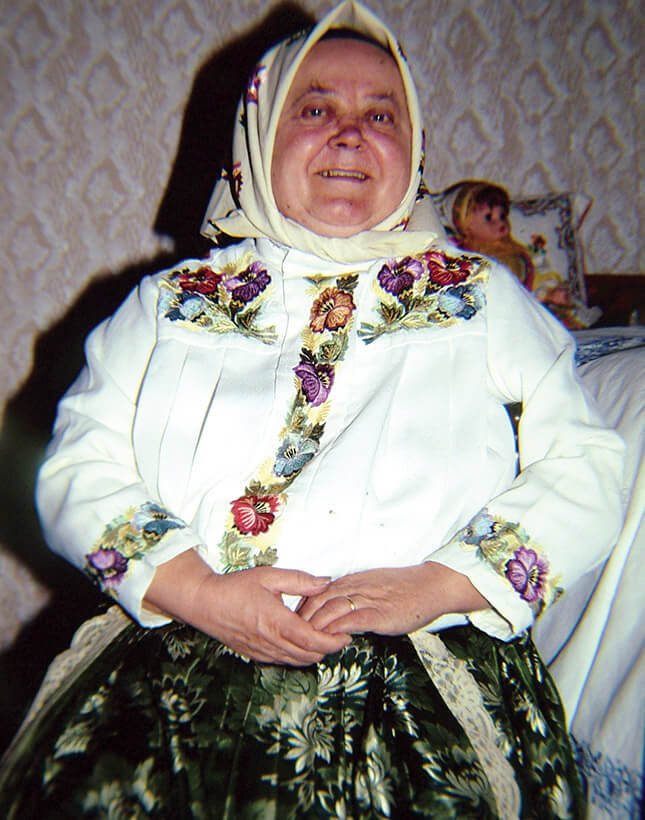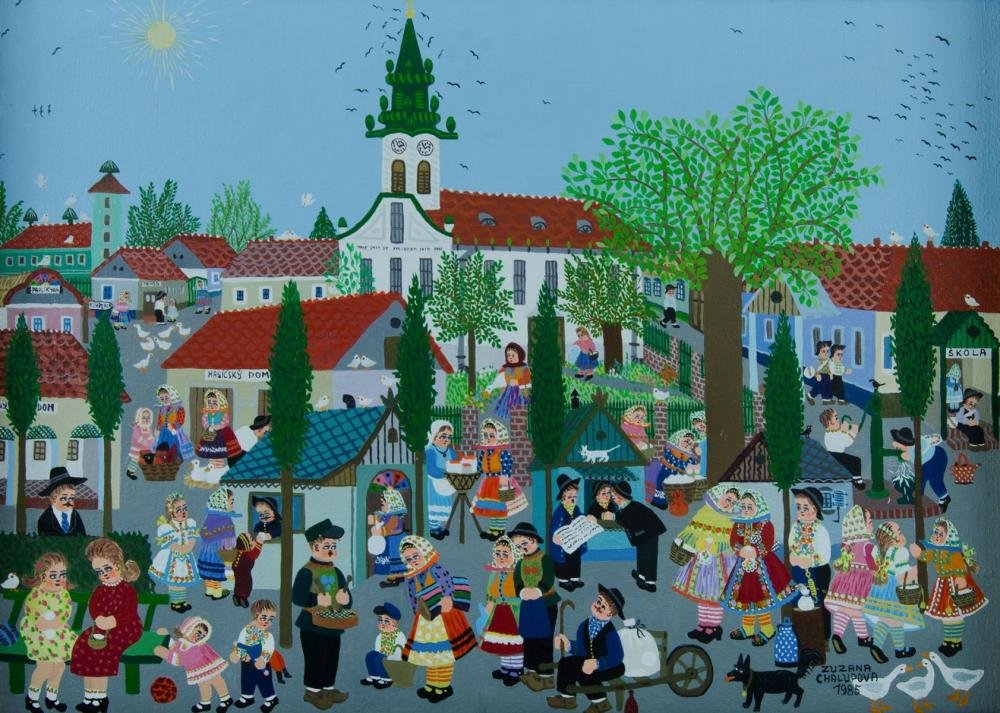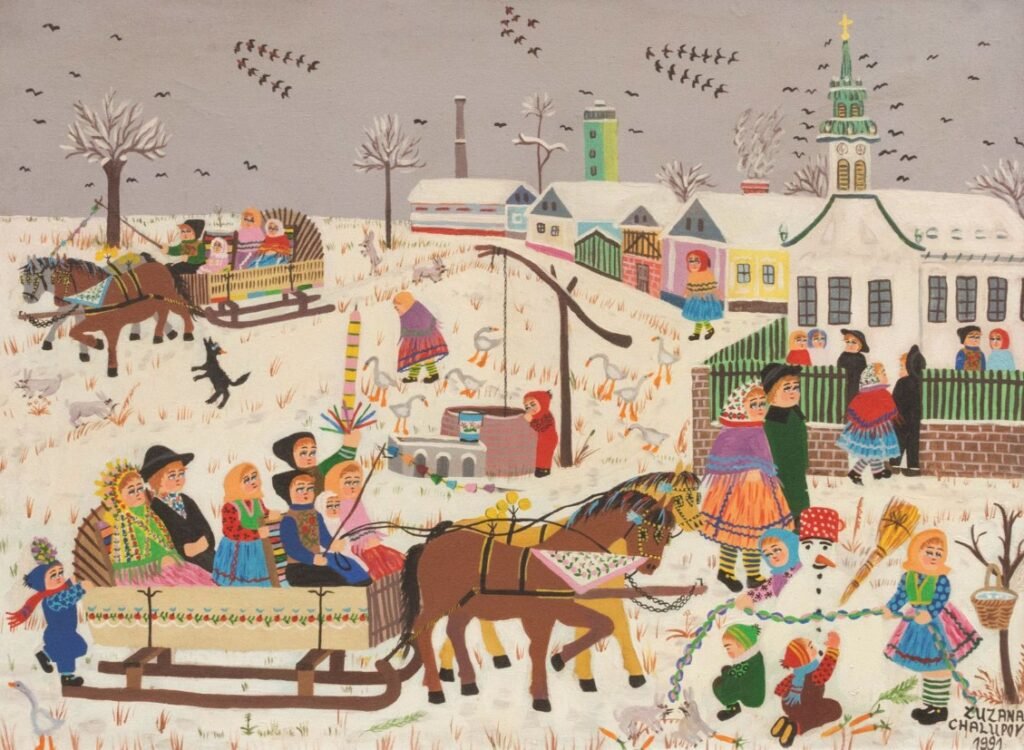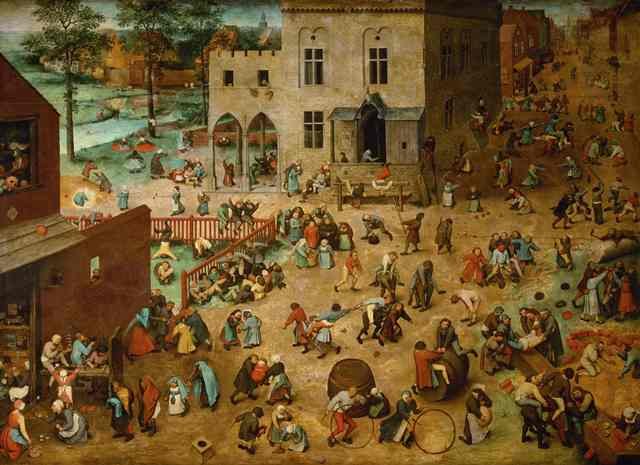From Slovakia to Serbia: A Life Between Worlds
Born in 1925 in Kovačica, a small town in what is today south Vojvodina (Banat provence), Chalupová was part of a Slovak minority community. Her identity—rooted in tradition, yet open to the multicultural tapestry of Vojvodina—shaped her visual language profoundly. She began painting relatively late in life, after a career in photography and social work. Perhaps because of this, her art never felt rushed; it radiated a sense of patience and joy that comes from truly observing life.
It was not fame she chased but truth—her truth, one painted in primary colors and smiling faces.
The Naïve Art Movement and Chalupová’s Place in It
Naïve art, often characterized by a childlike perspective, bold color palettes, and a lack of formal academic training, emerged as a powerful voice in the 20th century. Zuzana Chalupová became one of its most cherished exponents. Her works were neither ironic nor satirical but earnest and sincere, often carrying subtle social messages wrapped in warmth.
She was particularly known for her depictions of children—large-eyed, rosy-cheeked, and infinitely expressive. These children were not idealized but real, reflecting the joys and struggles of daily life. Yet, there was always a touch of magic: angels floated in the margins, doves flew over village rooftops, and sunflowers stood like sentinels watching over the land.

Zuzana Chalupová (Serbian: Зузана Халупова, romanized: Zuzana Halupova; 5 February 1925 – 1 August 2001)

Themes of Peace, Nature, and Community
Chalupová’s recurring motifs—peace doves, fields in bloom, village gatherings—were more than aesthetic choices. They reflected her philosophy: that art could be a force for good, a guardian of innocence, and a gentle protest against the violence and division that plagued much of the Balkans during her lifetime.
Despite the wars and political upheavals that unfolded around her, Chalupová’s canvases remained sanctuaries of hope. Her work with children, both in painting and in life, was a testament to her belief that the world could be better—so long as we nurtured it like a garden.
CHALUPOVÁ, ZUZANA DORFSZENE.
Legacy and Global Recognition
Zuzana Chalupová’s art traveled far beyond her small town. Her work was exhibited internationally—from Paris and Rome to New York and Tokyo—and she became a symbol of both Serbian and Slovak cultural heritage. Yet, she remained deeply rooted in her hometown, where the Gallery of Naïve Art in Kovačica continues to showcase her and other local artists’ works.
Today, Chalupová’s legacy endures not just in museums but in the way her art continues to inspire: not through grandeur or provocation, but through an unflinching celebration of the human spirit.
Conclusion
Zuzana Chalupová reminds us that art doesn’t need to be complex to be profound. In her paintings, we find a mirror to a simpler, kinder world—one where childhood is sacred, community is central, and every canvas is a prayer for peace. Her life was her art, and her art was her way of loving the world.

personal opinion:
Bruegel and Chalupová: Village Life on Canvas — A Dark Gaze and a Bright Joy
At first glance, Zuzana Chalupová and Pieter Bruegel the Elder might not seem to have much in common — one was a 16th-century Flemish master known for his dark irony and allegories, and the other a 20th-century naïve painter from the plains of Vojvodina. Yet something essential connects them: a deep interest in everyday life, in the people, the village, and the collective fate of “ordinary” folk.
Bruegel often depicted peasants at feasts, at work, dancing — but behind those scenes often lies a critique of human folly, greed, or inevitable fate. His perspective is satirical, often dark, even pessimistic.
In contrast, Zuzana Chalupová’s world radiates optimism and warmth. Her figures — often children, women, families, and animals — are not subjects of mockery or moral lessons, but rather a celebration of life. She uses a similar visual language: densely populated compositions, repeated figures, scenes of communal life — but with an entirely different emotional tone. There’s no fear of apocalypse in her work, only faith in peace, love, and togetherness.
While Bruegel often worked with earthy tones and darker palettes, Chalupová expresses herself through bright, cheerful colors — blues, reds, and golden hues — giving her paintings a dreamlike, almost fairytale atmosphere.
In this sense, I might say:
👉 Bruegel shows man as he is — with flaws and weaknesses. (Children’s_Game)
👉 Chalupová shows man as he could be — joyful, innocent, and at peace with the world. (Children’s wedding)


